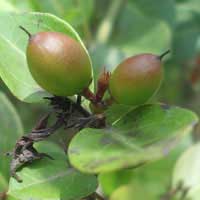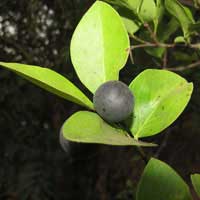 Full List of Fruits
Full List of Fruits  Conkerberry Fruit
Conkerberry FruitConkerberry Fruit
![]() Introduction of Conkerberry Fruit
Introduction of Conkerberry Fruit
Scientific name - Carissa spinarum
Scientifically known as Carissa spinarum, this fruit belongs to the Apocynaceae family. It is also known with more familiar names such as Bush currant, Australian native currant, Australian native plum, and conkerberry.
Having its roots in Central Australia. This plant suitably grows throughout the drier areas of northern and central Australia. Mostly spotted growing on a wide range of terrains and soil types. On the contrary in the wetter regions it tries to keep the vegetationrestrained to relatively wetter areas only.
Conkerberry is majorly found in the open woodlands and stony locations of tropical areas in Western Australia, the Northern Territory and Queensland. Even thoughthe occurring of conkerberry is mostly in humid areas, it has also been established to a limited extent in some desert areas of central Australia.
Growing up to be an evergreen perennial woody tangled shrub growing up to 2 m high with straight distribution of spines with a width of 5-7 mm long.
The occurrence of Flowering happens after rain, this results in the budding of the fragrant white flowers that give rise to green berries that over the period of time change from red to black as they ripen.
The shelf life of the fresh berries last only a few weeks on the bush, having said that the dried berries can be gathered from the ground and be repurposed for consumption by soaking them to rehydrate them. The berry comprises of two small distorted seeds. The outer flesh covering the seed taste to be pleasantly sweet, but when consumed in large quantities it may cause thirst.
![]() Nutritional Value of Conkerberry Fruit
Nutritional Value of Conkerberry Fruit
| Total Fat | 2.3g | 4% | |
| Saturated Fat | 1g | 5% | |
| Cholesterol | 1mg | 0% | |
| Sodium | 8mg | 0% | |
| Total Carb | 19g | 6% | |
| Fiber | 9.3g | 37% | |
| Sugars | 1g | ||
| Protein | 2.4g | 5% | |
| Vitamin A | 0% | ||
| Vitamin C | 7% | ||
| Calcium | 6% | ||
| Iron | 16% | ||
Conkerberry can be eaten straight out of hand or be used as an ingredient to make jams and jellies. Usually borne in pairs this berry has sweet and very pleasant taste. This fruit acts as an appetizer in a sick man's meal. After undergoing the process of fermentation this fruit can also be used to make vinegar. What looks like red-black fruit growing about 15mm in diameter it ripens to a blue-black colour after it falls of the tree. It's not just the fruit that is edible, the roots are put into water-gourds to add a delightful taste to the water. These roots are also added to soups and stews for adding flavor to the dish. The roots are used to disguise a strong smell of other food that is cooking. Making it a multi-purpose plant.
![]() Health benefits of Conkerberry Fruit
Health benefits of Conkerberry Fruit
This plant comes with a lot of medicinal properties that are help in aiding ailing beings, both man and animal. Conkerberry is known for anthelmintic action in Africa, anthelmintic action translates to the abortion of parasitic worms from human system. This anthelmintic property has also shown its positive action on animals as well. The consumption of the ground up root is effective remedy for venereal disease, this disease is caused due to sexuall contraction, which is often caused by bacteria, viruses or even parasites.
The method of consuming it is by chewing the root and swallowing the saliva. With an active property known as carissin present in the roots helps in treatment of many forms of cancer. The boiled leaves when applied on gums helps in reliving toothache. Used as an abortifacient this root helps in causing abortion, a severe precaution is to be taken while consuming the roots of conkerberry. The decoction derived from the leaves is used in treatment of various body ailments such as oral inflammation, earache, diarrhea and also intermittent fever.
All in all conkerberry is a fruit that not just pleases the taste buds but it is beneficial to health at large. Thus one must incorporate conkerberry in one's diet.
Having already said that the conkerberry plant is a tropical plant it can thrive in hot, usually drier tropics, where it is found growing at heights up to 1,600 meters. The ideal areas to grow conkerberry are in areas where annual daytime temperatures are within the range 20 - 35°c, but it has great resistance and can also withstand temperatures within the range of 10 - 39°c.
It favors a mean annual rainfall in the range 900 - 1,300mm to grow in a tropical area, but tolerates 700mm during droughts and can withstand 4,000mm during excessive rainfall. It normally requires a sunny position, and thus cannot be an ideal plant to be grown in wetter areas. A well-drained soil that is deep and fertile makes a healthy ground for the plants to grow, also to mention that the plant can survive in dry, sandy and rocky soils. In regions with wetter soils there will be extreme vegetative growth and lesser fruit production. For healthier vegetative growth conkerberry favors a pH level ranging 6.5 - 7.5, while tolerating 6 - 8. This is plant can flower and fruit throughout the year


















